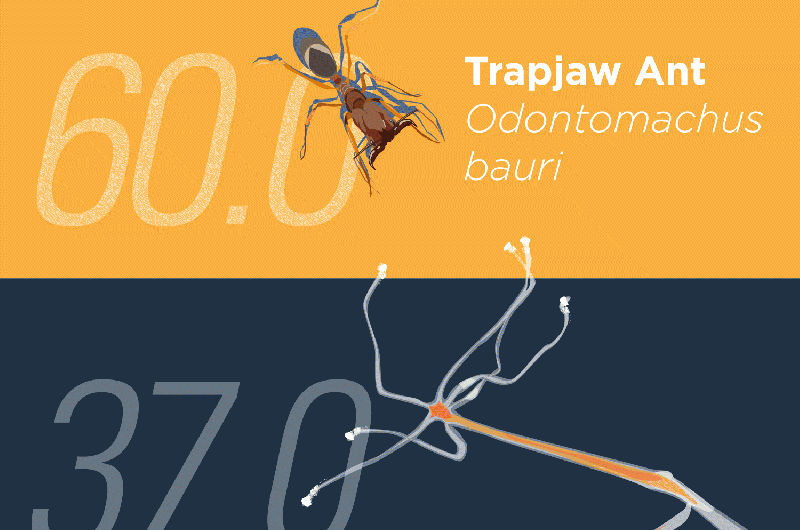Researcher studies how animals puncture things

If shooting arrows from a crossbow into cubes of ballistics gelatin doesn't sound like biological science to you, you've got a lot to learn from University of Illinois animal biology professor Philip Anderson, who did just that to answer a fundamental question about how animals use their fangs, claws and tentacles to puncture other animals.
Anderson conducted the study with Jeffrey LaCosse, of Charles E. Jordan High School in Durham, North Carolina, and Mark Pankow, of North Carolina State University, Raleigh.
By measuring how deeply an arrow - weighted to alter its mass between tests - penetrated a dense gelatin cube each time it was fired from a crossbow, the researchers found that the arrow's kinetic energy was the best predictor of its ability to penetrate its target. (See video below.)
They reported their results in the Royal Society journal Interface Focus.
The study is the first step of an effort to understand how nature, "red in tooth and claw," as the poet Alfred Tennyson wrote, uses tooth, claw, tentacles and even tools to capture food or defend against an enemy, competitor or predator.
"There are a lot of animals that have to puncture in order to survive," Anderson said.
"You have snakes that puncture with their fangs during strikes to inject venom. Some mantis shrimp, a group of marine crustaceans, use their very fast, power-amplified appendages to harpoon things like fish out of the water column and pull them down into their burrows to feed."
Stinging sea creatures like the Portuguese man-of-war also puncture their prey, but their puncturing apparatus is microscopic, Anderson said.
"They sting using single-celled organs on their tentacles called nematocysts, which are basically little hydrostatic, pressurized harpoons that inject venom," he said.
The speed of these puncturing events also varies widely. A snake strike occurs at roughly 3 meters (9.8 feet) per second. Mantis shrimp can harpoon prey at about 7 meters (23 feet) per second. And some trap-jaw ants puncture their prey or enemies by snapping their jaws shut at speeds of up to 60 meters per second.
"That's more than 130 miles per hour," Anderson said.
The researchers want to know how these and other organisms have each solved the puncture problem for themselves; they hope to determine whether some universal principles are at play.
"What's really cool from the evolutionary point of view is that it's not often that you have the ability to look at biomechanical systems across such a wide range of animals that are all trying to achieve a similar performance," Anderson said.
When slowed to a comprehensible speed (see video), the process of puncture is quite complex. First, one object (we'll call it an arrow) must hit a target with enough energy to initiate a crack in the target's surface. The impact creates stress waves, which move through the target material much like sound waves move through the air, Anderson said. These waves interact with the edges of the target, creating deformation.
After the initial impact, the arrow must open up new surface area inside its target, breaking molecular bonds and overcoming friction to penetrate more deeply into the target.
"The target material builds up elastic energy as it deforms. At a certain point the elastic energy in the material causes it to push back against the arrow," Anderson said. "If the elastic energy is large enough, it can eject the arrow. This rebound occurred in about half of the crossbow trials."
The arrow's shape, its mass and speed also play a role, as does the composition of the target.
In Anderson's experiments, the target was a 4-inch cube of ballistics gelatin, which often is used in ballistics studies to simulate the density of human tissue.
By firing the weighted arrow into numerous identical targets and calculating the velocity of each firing and the depth of penetration of the arrow, the researchers found that the arrow's kinetic energy was the best predictor of target penetration.
Kinetic energy is equal to half the object's mass multiplied by the velocity squared:
kinetic energy = ½ mass x velocity2
An object's mass and its speed (velocity) are critical to its kinetic energy. The fact that speed is squared (multiplied by itself) means that an increase in speed will magnify the kinetic energy of an object much more than a comparable increase in mass.
"This means that one potential way for small animals to puncture and get through tough materials, even with a low mass, is to increase their speed," Anderson said. "And if you look across animals that puncture, it appears that the smaller ones tend to be faster."
More information: "Point of impact: the effect of size and speed on puncture mechanics" DOI: 10.1098/rsfs.2015.0111
Provided by University of Illinois at Urbana-Champaign




















